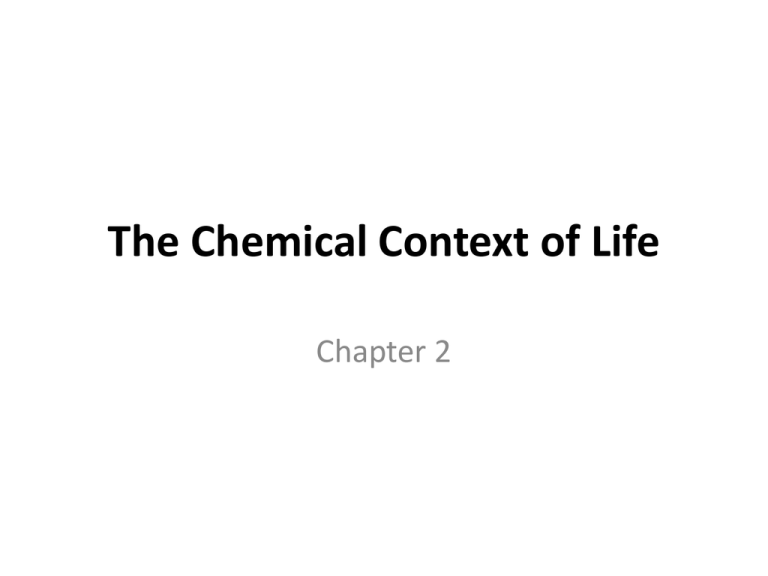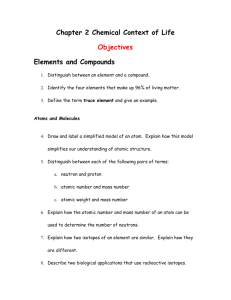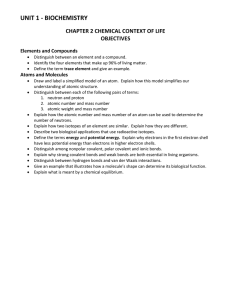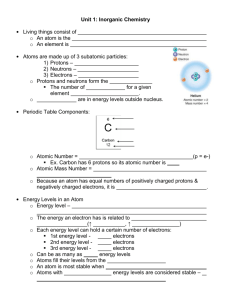Chapter 2
advertisement

The Chemical Context of Life Chapter 2 MATTER CONSISTS OF CHEMICAL ELEMENTS AND COMBINATIONS CALLED COMPOUNDS Elements and Compounds • Matter is made up of elements • Elements cannot be broken down any further by normal chemical reactions – 92 natural elements recognized by chemists – Gold (Au), Copper (Cu), Carbon (C), Oxygen (O) • Compounds are two or more elements combined in a fixed ratio – Table salt (NaCl), Water (H2O) – Properties of compounds are different than its individual elements The Elements of Life • C, H, O, and N makes up 96% of all living matter • Essential Elements are required by all organisms • Trace Elements – Only required in minute quantities – Often used as Cofactors for Enzymes Check Your Understanding • Differentiate between an element and a compound. Provide examples of each. • Which elements make up 96% of all living matter? • Differentiate between an essential element and a trace element. Provide example of each. Why are trace elements still important within an organisms diet? AN ELEMENT’S PROPERTIES DEPEND ON THE STRUCTURE OF ITS ATOMS Subatomic Particles • Atomic Nucleus – Protons (positive charge; mass of 1 Dalton) – Neutrons (no charge; mass of 1 Dalton) • Orbitals are where an atom’s electrons are found 90% of the time – Electrons (negative charge; no mass) Helium Atomic Mass and Atomic Number • Atomic Number denotes the number of protons – Neutral (uncharged) atoms have equal number of protons and electrons • Mass Number denotes the number of protons and neutrons in the nucleus – Atomic Mass ≈ Mass Number Isotopes • Possess more neutrons than normally present – Alters the atomic mass – Many isotopes are stable • Radioactive Isotopes are inherently unstable – Gives off particles and energy – Often used to tag proteins, to track the movement of fluids in the body, to identify tissues (PET scan) Energy Levels • Energy is the capacity to cause change – Potential Energy is a type of energy due to position or structure • Electrons have potential energy due to distance from atomic nucleus – Electron Shells Electron Distribution • Valence Electrons are the outermost electrons in an atom’s orbital – Valence Number is 2 for the first orbital and 8 for the second and third orbital • Valence Shell is the outermost orbital of a particular atom • An atom’s chemical behavior is determined by the interactions of its valence electrons Check Your Understanding • Differentiate between a proton, a neutron, and an electron. • Differentiate between atomic number and atomic mass. How do you determine an atoms number of protons, electrons, and neutrons if given only those two pieces of information? • What is an isotope? What are they commonly used for in medicine? • What is meant by the valence number of an atom? What is the valence number of electrons in the first, second, and third electron orbitals? Why is the valence number important to an atom? THE FORMATION AND FUNCTION OF MOLECULES DEPENDS ON CHEMICAL BONDS BETWEEN ATOMS Chemical Bonds • Attractions that keep atoms close together – Due to interactions between electrons of neighboring atoms • Strongest chemical bonds in Aqueous solutions are Covalent Bonds – Typical of biological systems • Ionic Bonds are generally strong when NOT present in aqueous solutions Electronegativity • Strength of attraction for a given atom to the electrons in a chemical bond • Determines if electrons are shared, how they are shared, or if they are transferred completely Covalent Bonds • Sharing of a pair of valence electrons between 2 atoms – Single Bonds – Double Bonds • Molecules are created by a covalent bond between 2 or more atoms Types of Covalent Bonds Nonpolar Covalent Polar Covalent Equal Sharing Unequal Sharing Ionic Bonds • One atom is so electronegative, it takes an electron from its partner • Result is one negatively-charged and one positively-charged atom (Ion) – Cations are positively charged – Anions are negatively charged • Resulting ions are held together by electrostatic interactions • Often results in salts such as NaCl, KCl, MgCl2 Weak Chemical Bonds • Hydrogen Bonds occur between polar molecules – Hydrogen of one is attracted to the electronegative atom of another • van der Waals Interactions are weak bonds based on the close proximity of molecules – Can be significant as the number of interacting molecules increases Molecular Shape and Function • Shape is determined by the way atoms bond to each other • Shape determines how molecules interact with other molecules – Determines a molecule’s function Check Your Understanding • Define electronegativity and describe how it determines the type of bonds an atom can form. • Differentiate between a covalent and an ionic bond. • Differentiate between a polar covalent and a nonpolar covalent bond. • Differentiate between a cation and an anion. • What is a hydrogen bond and how does it differ from both covalent and ionic bonds? • How do the chemicals endorphin and morphine illustrate the principle of “form fits function” even at the molecular level? CHEMICAL REACTIONS MAKE AND BREAK CHEMICAL BONDS Chemical Reactions • Making and breaking of chemical bonds – Reactants are the starting materials – Products are the end materials • Many biological reactions are Reversible • Most reactions occur until an Equilibrium is reached Reactants Products





